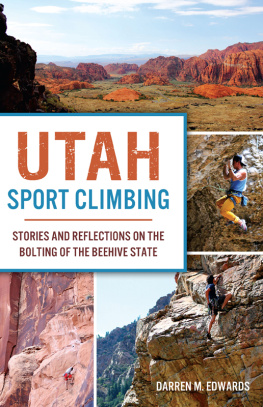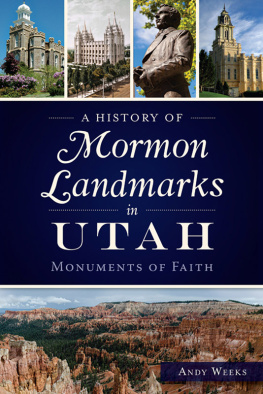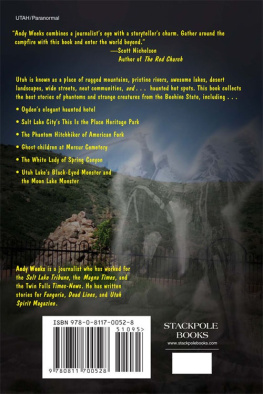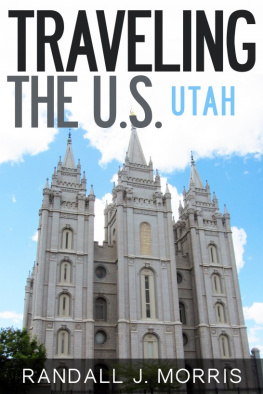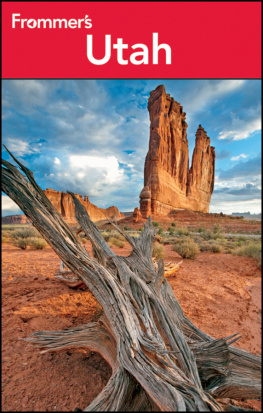


Published by The History Press
Charleston, SC
www.historypress.net
Copyright 2017 by Darren M. Edwards
All rights reserved
First published 2017
e-book edition 2017
ISBN 978.1.62585.679.1
Library of Congress Control Number: 2016950686
print edition ISBN 978.1.46711.909.2
Notice: The information in this book is true and complete to the best of our knowledge. It is offered without guarantee on the part of the author or The History Press. The author and The History Press disclaim all liability in connection with the use of this book.
All rights reserved. No part of this book may be reproduced or transmitted in any form whatsoever without prior written permission from the publisher except in the case of brief quotations embodied in critical articles and reviews.
To Niki, for all of the reasons that you already know.
CONTENTS
PREFACE
I first thought of writing this book for my masters thesis while earning my degree in literature and writing at Utah State University. But I had successfully written about climbing before, and I really wanted to challenge myself. So I wrote a spiritual memoir instead. Had I known how much work this book would actually take, it would have given me a second reason to switch topics.
I complain about the work it took to complete this project (over two years of research, most of which came from digging up primary sources), but it really has been a project of passion. I have spent over a decade of my life sport climbing. It has enabled me to grow more as a person than almost any other single activity. During this time, I have had the chance to take over one hundred people out for their first time climbing. Even with those who never went again, I could see that the experience changed them. In the space of one climbing route, a person can go through nearly every emotion possible. They can face and overcome levels of fear theyve never dealt with before. They can learn to trust their lives to others and be trusted in return.
I hold so much gratitude for the pioneers who ventured out into Utahs canyons with the vision and passion to find and develop those routes. I wanted to learn more about them, and the more I learned, the more I wanted to explore and share their stories.
Thats what this book is. Its a collection of stories pulled from the earliest days of sport climbing in some of Utahs major areas. It is not, and could not be, a comprehensive history. Rather, I approached this as one of my writing mentors, Chris Cokinos, might have: as part journalist and part poet. My goal was not just to tell their stories but to reflect on them and see what they could tell us about what it means to be human.
Some of these stories, like the development of American Fork Canyon, are well known. There I have tried to provide the most accurate telling to date. If nothing else, I wanted this book to get it right. Other stories seem completely unknown. Logan and Maple Canyons are good examples of stories that may be new to even the most die-hard Utah climbers.
It is important to make it clear that this book deals exclusively with sport climbing. Trying to tackle Utahs trad climbing and mountaineering history would be its own overwhelming task. I will leave that task to someone else. I look forward to reading that work.
I had a number of audiences in mind while writing this book. First, I wanted to write it for the climbing community, to record a history that might otherwise be lost to time. Second, I wanted to write this for the non-climber so that he or she could enjoy learning from the rich history these climbers have created. Lastly, I hoped to create something of beauty for the literary community.
For the uninitiated, the language and terminology involved in rock climbing can be a bit intimidating. This presented a unique challenge for the writing of this book. How do you explain the climbing shop speak for the non-climber without boring the climber to death? So, rather than explaining what a red-point is the first time it comes up in each chapter, Ive created a small glossary of climbing terminology at the back of the book. My hope is that this tool will aid the average person as he or she enjoys this fascinating piece of Utahs history.
A few notes: Ive italicized the names of specific climbing routes but not the names of crags, walls or canyons. Route names are almost always followed by a parenthetical that contains the climbs difficulty rating (all ratings are given using the Yosemite decimal system) followed by a comma, the letters FA (first ascent) and the name of the climber/s who claimed the first ascent. Most routes are also accompanied by an endnote that provides readers with the guidebook the information was pulled from.
The Yosemite decimal system is used to rate the difficulty of a route. The system is divided into five types of activity, from walking and hiking to rock climbing. All sport routes would fall into category 5. The 5 is then followed with the difficulty of the climb. When I started climbing, anything below 5.10 was considered a beginner route. After 5.10, the difficulty grades further subdivide into a, b, c and d. So, a 5.10b is one grade more difficult than a 5.10a. After 5.10d, the next designation would be 5.11 and so on. The general feeling among the climbers I knew or spoke to in the 1990s was that 5.12 marked the start of expert-level routes, with 5.13 and 5.14 serving as even higher benchmarks. The end of the scale continues to change as climbers push the boundaries of the sport.
To any and all climbers who feel hurt that they werent interviewed for this project, congratulations, you have very successfully taken yourself off the grid, and I apologize I didnt have the strength, time or energy to track each and every one of you down.
I hope you enjoy reading this history, and I look forward to seeing my recording of it torn apart on Mountain Project (which I figured would happen no matter how I did it).
ACKNOWLEDGEMENTS
I would like to thank Niki Edwards, without whose support this book (and pretty much everything Ive done for the past five years) would not have been possible; Sandy Edwards, who got me through high school, a monumental task, and always supported my creative endeavors; Jerry Edwards, for teaching me the importance of doing things the right way and instilling in me a work ethic I would not otherwise have; and my siblings: Curry, for keeping me open-minded; Jenn, for midnight fry runs and always welcoming me into your home; and Special-K, for helping me survive the other two. To all of my nieces and nephews (Grahm, Aiden, Alex, Johna, Miles, Beck and Luci), thank you for keeping me young. To my son, Michael Dean Edwards, you were only weeks old as I finished up this project, so I wont hold my lack of sleep against you.
I would like to thank my editor Artie Crisp and The History Press for their understanding in granting me multiple deadline extensions as I continued to stalk climbers, trying to set up interviews.
This book would still be an idea in my head without the help of hundreds of climbers, from beginners to masters, who helped with the research that brought this project to life. Thank you to those people who helped me connect the dots and make contact with the climbers whose histories I was writing. I appreciate everyone who allowed me to barge into their afternoon of climbing and let me photograph them. I stood on the shoulders of several guidebook authors while researching this project (James Garrett, Stuart and Bret Ruckman, Tim Monsell, Todd Goss, David G. Robb, Casey Hyer, Karl Kelley, Dave Pegg, Sibylle Hechtel and Josh Holmes). Also, a large thanks goes to Matt Driscoll for the work he did with the Outdoor Recreation History Project.
Next page
